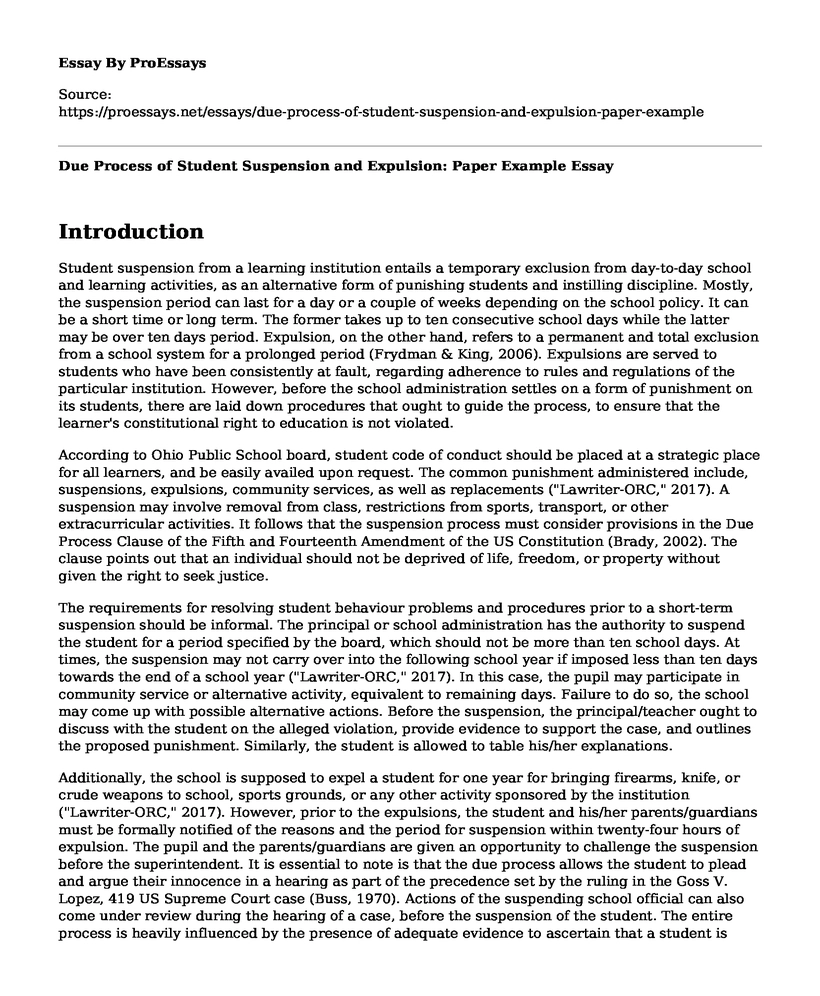Introduction
Student suspension from a learning institution entails a temporary exclusion from day-to-day school and learning activities, as an alternative form of punishing students and instilling discipline. Mostly, the suspension period can last for a day or a couple of weeks depending on the school policy. It can be a short time or long term. The former takes up to ten consecutive school days while the latter may be over ten days period. Expulsion, on the other hand, refers to a permanent and total exclusion from a school system for a prolonged period (Frydman & King, 2006). Expulsions are served to students who have been consistently at fault, regarding adherence to rules and regulations of the particular institution. However, before the school administration settles on a form of punishment on its students, there are laid down procedures that ought to guide the process, to ensure that the learner's constitutional right to education is not violated.
According to Ohio Public School board, student code of conduct should be placed at a strategic place for all learners, and be easily availed upon request. The common punishment administered include, suspensions, expulsions, community services, as well as replacements ("Lawriter-ORC," 2017). A suspension may involve removal from class, restrictions from sports, transport, or other extracurricular activities. It follows that the suspension process must consider provisions in the Due Process Clause of the Fifth and Fourteenth Amendment of the US Constitution (Brady, 2002). The clause points out that an individual should not be deprived of life, freedom, or property without given the right to seek justice.
The requirements for resolving student behaviour problems and procedures prior to a short-term suspension should be informal. The principal or school administration has the authority to suspend the student for a period specified by the board, which should not be more than ten school days. At times, the suspension may not carry over into the following school year if imposed less than ten days towards the end of a school year ("Lawriter-ORC," 2017). In this case, the pupil may participate in community service or alternative activity, equivalent to remaining days. Failure to do so, the school may come up with possible alternative actions. Before the suspension, the principal/teacher ought to discuss with the student on the alleged violation, provide evidence to support the case, and outlines the proposed punishment. Similarly, the student is allowed to table his/her explanations.
Additionally, the school is supposed to expel a student for one year for bringing firearms, knife, or crude weapons to school, sports grounds, or any other activity sponsored by the institution ("Lawriter-ORC," 2017). However, prior to the expulsions, the student and his/her parents/guardians must be formally notified of the reasons and the period for suspension within twenty-four hours of expulsion. The pupil and the parents/guardians are given an opportunity to challenge the suspension before the superintendent. It is essential to note is that the due process allows the student to plead and argue their innocence in a hearing as part of the precedence set by the ruling in the Goss V. Lopez, 419 US Supreme Court case (Buss, 1970). Actions of the suspending school official can also come under review during the hearing of a case, before the suspension of the student. The entire process is heavily influenced by the presence of adequate evidence to ascertain that a student is being punished for a violation they truly committed.
The due process is, in essence, a guarantee of basic fairness and the knowledge that decisions to suspend or expel students are guided and based on substantial evidence. The approach in its entirety does not quite differ much, whether it is a short-term or a long-term case since, primarily, the learner's right to education is inalienable. However, unlike in short-term suspensions, the expulsion under long-term category extends to the next academic year of the school calendar ("Lawriter-ORC," 2017). Another significant difference is that, in short-term suspensions, the student receives informal notification to expulsion, while in the long term; a formal notice is given to the student and parents. It is also likely that students preparing their defence against a long-term suspension will require considerably more time as compared to a short-term suspension.
Conclusion
It is clear that these requirements are consistent with guidelines set by the Supreme Court in Goss V. Lopez, as they fundamentally acknowledge a learner's legitimate claim to public education. This legal right is hence, protected by the due process clause and it cannot be withdrawn without meeting the minimum threshold set by the provision. The clause seeks to facilitate fair procedures in a bid to safeguard against unjust and arbitrary deprival of the stated rights.
References
Brady, K. P. (2002). Zero tolerance or (in) tolerance policies-weapon-less school violence, due process, and the law of student Suspensions and Expulsions: An examination of Fuller v. Decatur public school board of education school district. BYU Education & Law Journal, 159.
Buss, W. G. (1970). Procedural due process for school discipline: Probing the constitutional outline. University of Pennsylvania Law Review, 119, 545.
Frydman, M., & King, S. (2006). School discipline 101: Students' due process rights in expulsion hearings. Clearinghouse Rev, 40, 370.
Lawriter-ORC (2017). 3313.66 Suspension, expulsion or permanent exclusion- removal from curricular or extracurricular activities. Retrieved from http://codes.ohio.gov/orc/3313.66v1
Cite this page
Due Process of Student Suspension and Expulsion: Paper Example. (2022, Apr 02). Retrieved from https://proessays.net/essays/due-process-of-student-suspension-and-expulsion-paper-example
If you are the original author of this essay and no longer wish to have it published on the ProEssays website, please click below to request its removal:
- Essay Sample on General English
- Child Welfare and Information and Communication Technology
- Survey Education: Journal Reflection
- Analysis of the Biblical Text Essay
- The Difference Between Truth and Opinion Paper Example
- Essay Example on Instructing Kids: A Tool to Fight Plagiarism and Build Confidence
- Essay Sample on Student-Athletes: The Powerhouses of the Sports Industry







